Type 2 diabetes is a lifelong (chronic) disease in which there is a high level of sugar (glucose) in the blood. Type 2 diabetes is the most common form of diabetes.
Causes
Insulin is a hormone produced in the pancreas by special cells, called beta cells. The pancreas is below and behind the stomach. Insulin is needed to move glucose into cells. Inside the cells, glucose is stored and later used for energy.
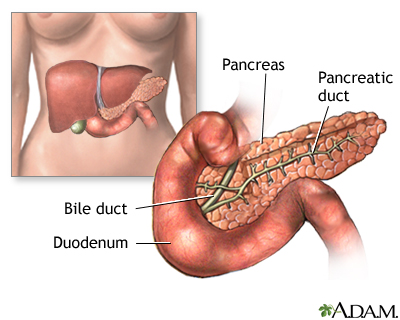
When you have type 2 diabetes, your fat, liver, and muscle cells do not respond correctly to insulin. This is called insulin resistance. As a result, glucose does not get into these cells to be stored for energy.
When sugar cannot enter cells, a high level of sugar builds up in the blood. This is called hyperglycemia. The body is unable to use the glucose for energy. This leads to the symptoms of type 2 diabetes.
Type 2 diabetes usually develops slowly over time. Most people with the disease are overweight or obese when they are diagnosed. Increased fat makes it harder for your body to use insulin the correct way.
Type 2 diabetes can also develop in people who are not overweight or obese. This is more common in older adults.
Family history and genes play a role in type 2 diabetes. Low activity level, poor diet, and excess body weight around the waist increase your chance of getting the disease.
Symptoms
People with type 2 diabetes often have no symptoms at first. They may not have symptoms for many years. Some people who have type 2 diabetes that develops slowly already have eye, kidney, or nerve damage when they are first diagnosed.
Early symptoms of diabetes caused by a high blood sugar level may include:
- Bladder, kidney, skin, or other infections that are more frequent or heal slowly
- Fatigue
- Hunger
- Increased thirst
- Increased urination
- Blurred vision
After many years, diabetes can lead to serious health problems, and as a result, many other complications.
Exams and Tests
Your health care provider may suspect that you have diabetes if your blood sugar level is 200 milligrams per deciliter (mg/dL) or 11.1 millimoles per liter (mmol/L) or higher. To confirm the diagnosis, one or more of the following tests must be done.
- Fasting blood glucose level -- Diabetes is diagnosed if it is 126 mg/dL (7.0 mmol/L) or higher two different times when the person is in their usual state of health.
- Hemoglobin A1C test (A1C) -- Diabetes is diagnosed if the test result is 6.5% or higher.
- Oral glucose tolerance test -- Diabetes is diagnosed if the glucose level is 200 mg/dL (11.1 mmol/L) or higher 2 hours after drinking a special sugar drink.
Diabetes screening is recommended for:
- Overweight or obese adults (BMI of 25 or higher) starting at age 35 and repeated every 3 years
- Overweight women who have other risk factors, such as high blood pressure, who are planning to become pregnant
- All adults starting at age 35, repeated every 3 years or at a younger age if the person has risk factors such as high blood pressure, or having a mother, father, sister, or brother with diabetes
In 2022, the US Preventive Services Task Force concluded that there was not enough evidence to recommend screening for type 2 diabetes in people 18 years old or younger. Some experts do advocate such screening for overweight children. Ask your child's provider what is best for them.
If you have been diagnosed with type 2 diabetes, you need to work closely with your provider. See your provider as often as instructed. This may be every 3 months.
The following exams and tests will help you and your provider monitor your diabetes and prevent problems.
- Check the skin, nerves, and joints of your feet and legs.
- Check if your feet are getting numb (diabetic nerve disease).
- Have your blood pressure checked at least once a year (blood pressure goal should be 130/80 mm Hg or lower).
- Have your A1C tested every 6 months if your diabetes is well controlled. Have the test every 3 months if your diabetes is not well controlled.
- Have your cholesterol and triglyceride levels checked once a year.
- Get tests at least once a year to make sure your kidneys are working well (microalbuminuria and serum creatinine).
- Visit your eye doctor at least once a year, or more often if you have signs of diabetic eye disease.
- See your dentist every 6 months for a thorough dental cleaning and exam. Make sure your dentist and hygienist know that you have diabetes.
Your provider should check your vitamin B12 blood levels if you are taking the medicine metformin.
Treatment
At first, the goal of treatment is to lower your high blood glucose level. Long-term goals are to prevent complications. These are health problems that can result from having diabetes.
The most important lifestyle approach to treating and managing type 2 diabetes is by being active and eating healthy foods.
Everyone with diabetes should receive proper education and support about the best ways to manage their diabetes. Ask your provider about seeing a certified diabetes care and education specialist (CDCES) and a dietitian.
LEARN THESE SKILLS
Learning diabetes management skills will help you live well with diabetes. These skills help prevent health problems and the need for medical care. Skills include:
- How to test and record your blood glucose
- What, when, and how much to eat
- How to safely increase your activity and control your weight
- How to take medicines, if needed
- How to recognize and treat low and high blood sugar
- How to handle sick days
- Where to buy diabetes supplies and how to store them
It may take several months to learn these skills. Keep learning about diabetes, its complications, and how to control and live well with the disease. Stay up-to-date on new research and treatments. Make sure you are getting information from trustworthy sources, such as your provider and diabetes educator.
MANAGING YOUR BLOOD SUGAR
Checking your blood sugar level yourself and writing down the results tells you how well you are managing your diabetes. Talk to your provider and diabetes educator about how often to check.
To check your blood sugar level, you use a device called a glucose meter. Usually, you prick your finger with a small needle, called a lancet. This gives you a tiny drop of blood. You place the blood on a test strip and put the strip into the meter. The meter gives you a reading that tells you the level of your blood sugar.
Your provider or diabetes educator will help set up a testing schedule for you. Your provider will help you set a target range for your blood sugar numbers. Keep these factors in mind:
- Most people with type 2 diabetes only need to check their blood sugar once or twice a day.
- If your blood sugar level is under control, you may only need to check it a few times a week or even less often.
- You may test yourself when you wake up, before meals, and at bedtime.
- You may need to test more often when you are sick or under stress.
- You may need to test more often if you are having more frequent low blood sugar symptoms.
Keep a record of your blood sugar for yourself and your provider. This can often be done most easily using a website designed for this purpose. Based on your numbers, you may need to make changes to your meals, activity, or medicines to keep your blood sugar level in the right range. Always bring your blood glucose meter to medical appointments so the data can be downloaded and discussed.
Your provider may recommend that you use a continuous glucose monitor (CGM) to measure blood sugar if:
- You are using insulin injections many times a day
- You have had an episode of severe low blood sugar
- Your blood sugar level varies a lot
The CGM has a sensor that is inserted just under the skin to measure glucose in your tissue fluid every 5 minutes.
HEALTHY EATING AND WEIGHT CONTROL
Work closely with your providers to learn how much fat, protein, and carbohydrates you need in your diet. Your meal plans should fit your lifestyle and habits and should include foods that you like.
Managing your weight and having a well-balanced diet are important. Some people with type 2 diabetes can stop taking medicines after losing weight. This does not mean that their diabetes is cured. They still have diabetes.
Obese people whose diabetes is not well managed with diet and medicine may consider weight loss (bariatric) surgery.
REGULAR PHYSICAL ACTIVITY
Regular activity is important for everyone. It is even more important when you have diabetes. Exercise is good for your health because it:
- Lowers your blood sugar level without medicine
- Burns extra calories and fat to help manage your weight
- Improves blood flow and blood pressure
- Increases your energy level
- Improves your ability to handle stress
Talk to your provider before starting any exercise program. People with type 2 diabetes may need to take special steps before, during, and after physical activity or exercise, including adjusting doses of insulin if needed.
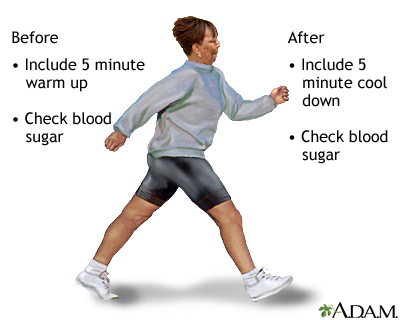
MEDICINES TO TREAT DIABETES
If diet and exercise do not help keep your blood sugar at normal or near-normal levels, your provider may prescribe medicine. Since these medicines help lower your blood sugar level in different ways, your provider may have you take more than one medicine.
Some of the most common types of medicines are listed below. They are taken by mouth or injection.
- Alpha-glucosidase inhibitors
- Biguanides
- Bile acid sequestrants
- DPP-4 inhibitors
- Injectable medicines (GLP-1 agonists or insulin)
- Meglitinides
- SGLT2 inhibitors
- Sulfonylureas
- Thiazolidinediones
You may need to take insulin if your blood sugar cannot be controlled with other medicines. Most commonly, insulin is injected under the skin using a syringe, insulin pen, or pump. Another form of insulin is the inhaled type. Insulin cannot be taken by mouth because the acid in the stomach destroys the insulin.
PREVENTING COMPLICATIONS
Your provider may prescribe medicines or other treatments to reduce your chance of developing some of the more common complications of diabetes, including:
- Eye disease
- Kidney disease
- Heart disease and stroke
FOOT CARE
People with diabetes are more likely than those without diabetes to have foot problems. Diabetes damages the nerves. This can make your feet less able to feel pressure, pain, heat, or cold. You may not notice a foot injury until you have severe damage to the skin and tissue below, or you get a severe infection.
Diabetes can also damage blood vessels. Small sores or breaks in the skin may become deeper skin sores (ulcers). The affected limb may need to be amputated if these skin ulcers do not heal or become larger, deeper, or infected.
To prevent problems with your feet:
- Stop using tobacco, if you use it.
- Improve control of your blood sugar.
- Get a foot exam by your provider at least once a year to learn if you have nerve damage.
- Ask your provider to check your feet for problems such as calluses, bunions or hammertoes. These need to be treated to prevent skin breakdown and ulcers.
- Check and care for your feet every day. This is very important when you already have nerve or blood vessel damage or foot problems.
- Treat minor infections, such as athlete's foot, right away.
- Use moisturizing lotion on dry skin.
- Make sure you wear the right kind of shoes. Ask your provider what type of shoe is right for you.
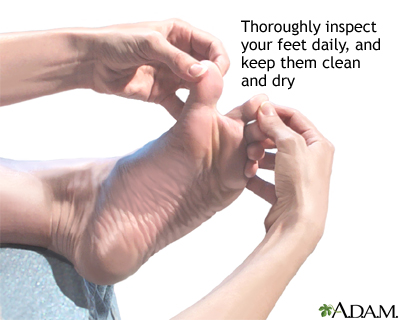
EMOTIONAL HEALTH
Living with diabetes can be stressful. You may feel overwhelmed by everything you need to do to manage your diabetes. But taking care of your emotional health is just as important as your physical health.
Ways to relieve stress include:
- Listening to relaxing music
- Meditating to take your mind off your worries
- Deep breathing to help relieve physical tension
- Doing yoga, tai chi, or progressive relaxation
Feeling sad or down (depressed) or anxious sometimes is normal. But if you have these feelings often and they're getting in the way of managing your diabetes, talk with your health care team. They can find ways to help you feel better.
People with diabetes should make sure to keep up on their vaccination schedule.
Support Groups
There are many diabetes resources that can help you understand more about type 2 diabetes. You can also learn ways to manage your condition so you can live well with diabetes.
More information and support for people with diabetes and their families can be found at:
- American Diabetes Association -- www.diabetes.org
- National Institute of Diabetes and Digestive and Kidney Diseases -- www.niddk.nih.gov/health-information/diabetes
Outlook (Prognosis)
Diabetes is a lifelong disease and there is no cure.
Some people with type 2 diabetes no longer need medicine for blood sugar control if they lose weight and become more active. When they reach their ideal weight, their body's own insulin and a healthy diet can control their blood sugar level.
Possible Complications
After many years, diabetes can lead to serious health problems:
- You could have eye problems, including trouble seeing (especially at night), cataracts, and light sensitivity. You could become blind.
- Your feet and skin can develop sores and infections. If the wounds do not heal properly, your foot or leg may need to be amputated. Infections can also cause pain and itching in the skin.
- Diabetes may make it harder to control your blood pressure and cholesterol. This can lead to a heart attack, stroke, and other problems. It can become harder for blood to flow to your legs and feet.
- Nerves in your body can get damaged, causing pain, tingling, and numbness.
- Because of nerve damage, you could have problems digesting the food you eat. You could feel weakness or have trouble going to the bathroom. Nerve damage can make it harder for men to have an erection.
- High blood sugar and other problems can lead to kidney damage. Your kidneys may not work as well as they used to. They may even stop working so that you need dialysis or a kidney transplant.
- High blood sugar can weaken your immune system. This may make it more likely for you to get infections, including life-threatening skin and fungal infections.
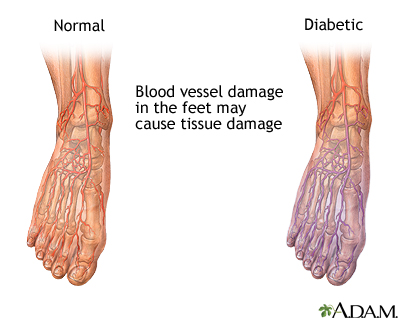
When to Contact a Medical Professional
Call 911 or the local emergency number right away if you have:
- Chest pain or pressure
- Fainting, confusion or unconsciousness
- Seizure
- Shortness of breath
- Red, painful skin that is spreading quickly
These symptoms can quickly get worse and become emergency conditions (such as seizures, hypoglycemic coma or hyperglycemic coma).
Also contact your provider if you have:
- Blood sugar levels that are higher than the goals you and your provider have set
- Numbness, tingling, or pain in your feet or legs
- Problems with your eyesight
- Sores or infections on your feet
- Frequent feelings of depression or anxiety
- Symptoms that your blood sugar is getting too low (weakness or fatigue, trembling, sweating, irritability, trouble thinking clearly, fast heartbeat, double or blurry vision, uneasy feeling)
- Symptoms that your blood sugar is too high (thirst, blurry vision, dry skin, weakness or fatigue, need to urinate a lot)
- Blood sugar readings that are below 70 mg/dL (3.9 mmol/L)
You can treat early signs of hypoglycemia at home by drinking orange juice, eating sugar or candy, or by taking glucose tablets. If signs of hypoglycemia continue or your blood glucose level stays below 60 mg/dL (3.3 mmol/L ), go to the emergency room.
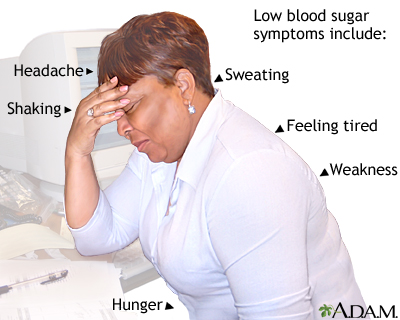
Prevention
You can help prevent type 2 diabetes by staying at a healthy body weight. You can get to a healthy weight by eating healthy foods, controlling your portion sizes, and leading an active lifestyle. Some medicines can also delay or prevent type 2 diabetes in people with prediabetes who are at risk for developing the disease.
Alternative Names
Diabetes - type II; Adult-onset diabetes; Diabetic - type 2 diabetes; Oral hypoglycemic - type 2 diabetes; High blood sugar - type 2 diabetes
Patient Instructions
- ACE inhibitors
- After weight-loss surgery - what to ask your doctor
- Before weight-loss surgery - what to ask your doctor
- Diabetes and exercise
- Diabetes eye care
- Diabetes - foot ulcers
- Diabetes - keeping active
- Diabetes - preventing heart attack and stroke
- Diabetes - taking care of your feet
- Diabetes tests and checkups
- Diabetes - when you are sick
- Foot amputation - discharge
- Gastric bypass surgery - discharge
- Laparoscopic gastric banding - discharge
- Leg amputation - discharge
- Leg or foot amputation - dressing change
- Low blood sugar - self-care
- Managing your blood sugar
- Type 2 diabetes - what to ask your doctor
Images
 Pancreas
Pancreas Diabetes and exercise
Diabetes and exercise Diabetic foot care
Diabetic foot care Diabetic emergency supplies
Diabetic emergency supplies 15/15 rule
15/15 rule Starchy foods
Starchy foods Diabetic blood circulation in foot
Diabetic blood circulation in foot Low blood sugar symptoms
Low blood sugar symptoms Glucose in blood
Glucose in blood Alpha-glucosidase inhibitors
Alpha-glucosidase inhibitors Biguanides
Biguanides Sulfonylureas drug
Sulfonylureas drug Thiazolidinediones
Thiazolidinediones Food and insulin release
Food and insulin release Monitoring blood glucose - Series
Monitoring blood glucose - Series Insulin production and diabetes
Insulin production and diabetes
References
American Diabetes Association Professional Practice Committee. 2. Classification and diagnosis of diabetes: standards of care in diabetes-2024. Diabetes Care. 2024;47(Suppl 1):S20-S42. PMID: 38078589 pubmed.ncbi.nlm.nih.gov/38078589/.
American Diabetes Association Professional Practice Committee. 8. Obesity and weight management for the prevention and treatment of type 2 diabetes: standards of care in diabetes-2024. Diabetes Care. 2024;47(Suppl 1):S145-S157. PMID: 38078578 pubmed.ncbi.nlm.nih.gov/38078578/.
American Diabetes Association Professional Practice Committee. 12. Retinopathy, neuropathy, and foot care: standards of care in diabetes-2024. Diabetes Care. 2024;47(Suppl 1):S231-S243. PMID: 38078577 pubmed.ncbi.nlm.nih.gov/38078577/.
Riddle MC, Ahmann AJ. Therapeutics of type 2 diabetes mellitus. In: Melmed S, Auchus, RJ, Goldfine AB, Koenig RJ, Rosen CJ, eds. Williams Textbook of Endocrinology. 14th ed. Philadelphia, PA: Elsevier; 2020:chap 35.
US Preventive Services Task Force website. Final recommendation statement: Prediabetes and type 2 diabetes: Screening. www.uspreventiveservicestaskforce.org/uspstf/recommendation/screening-for-prediabetes-and-type-2-diabetes. Released August 24, 2021. Accessed February 20, 2024.
US Preventive Services Task Force website. Final recommendation statement: Prediabetes and type 2 diabetes in children and adolescents: Screening. www.uspreventiveservicestaskforce.org/uspstf/recommendation/prediabetes-type2-diabetes-children-adolescents-screening. Released September 13, 2022. Accessed February 20, 2024.
Test Your Knowledge
Review Date 2/10/2023
Updated by: Sandeep K. Dhaliwal, MD, board-certified in Diabetes, Endocrinology, and Metabolism, Springfield, VA. Internal review and update on 02/20/2024 by David C. Dugdale, MD, Medical Director, Brenda Conaway, Editorial Director, and the A.D.A.M. Editorial team.


















